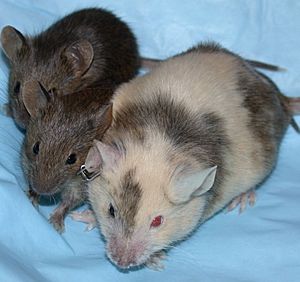Gene targeting facts for kids

Gene targeting is a special way to change genes in living things. It's like replacing a part of a computer code with a new, slightly different part. Scientists use this method to study how genes work. They can change a gene, remove parts of it, or even add a new gene.
This technique helps us understand diseases and how bodies develop. It can be done in lab mice and other model organisms. A model organism is a living thing that is easy to study in a lab.
Sometimes, the gene change is permanent. Other times, it's conditional. This means the change only happens at a certain time, like during development. Or it might only affect a specific part of the body.
Gene targeting has been used in many different living things. These include Drosophila melanogaster (fruit flies), tobacco plants, corn, human cells, mice, and rats.
Contents
Nobel Prize for Gene Targeting
In 2007, three scientists won the Nobel Prize in Physiology or Medicine. They were Mario R. Capecchi, Martin J. Evans, and Oliver Smithies. They won for their important work on gene targeting.
Their discoveries showed how to make specific changes to genes in mice. They used special cells called embryonic stem cells. This work was a big step forward in understanding genetics.
How Gene Targeting Works in Mice
Scientists often use mice to study gene targeting. Here's a simple way it works:
Making the DNA Change
First, scientists create a special piece of DNA. Think of it as a tiny instruction manual. This manual contains the changed gene they want to put into the mouse. They usually make many copies of this DNA in bacteria.
This special DNA also has a "reporter gene." This gene acts like a visible marker. It helps scientists find the cells that have successfully taken in the new DNA. For example, it might make cells glow or change color.
Inserting into Stem Cells
Next, the changed DNA is put into mouse stem cells. These stem cells come from a mouse embryo. They are very special because they can grow into any type of cell in the body. This process happens in a lab dish, also called tissue culture.
Scientists then check which stem cells have the correct DNA change. The reporter gene helps them find these cells. For example, if the reporter gene makes cells white, they can easily pick out the white cells.
Creating Chimeric Mice
The treated stem cells are then put into a very early mouse embryo. This embryo is then placed into a mother mouse. The baby mice born from this process are called "chimeric" mice. This means they have a mix of cells: some with the original genes and some with the changed genes.
Scientists look for chimeric mice where the changed cells are in the reproductive organs. These are the parts that make babies.
Breeding for the Changed Gene
These special chimeric mice are then bred with other mice. If the changed cells are in the reproductive organs, some of the baby mice will inherit the altered gene.
Scientists can then breed these mice again. This helps them get mice where every cell in their body has the altered gene. These mice are then ready for studies. Scientists can observe how the changed gene affects the mouse's health, development, or behavior.
Images for kids
See also
 In Spanish: Gene targeting para niños
In Spanish: Gene targeting para niños


